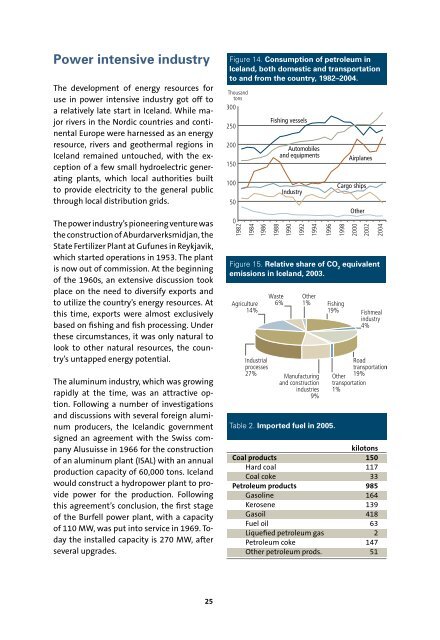ENERGY IN ICELAND - Orkustofnun
ENERGY IN ICELAND - Orkustofnun
ENERGY IN ICELAND - Orkustofnun
You also want an ePaper? Increase the reach of your titles
YUMPU automatically turns print PDFs into web optimized ePapers that Google loves.
Power intensive industryThe development of energy resources foruse in power intensive industry got off toa relatively late start in Iceland. While majorrivers in the Nordic countries and continentalEurope were harnessed as an energyresource, rivers and geothermal regions inIceland remained untouched, with the exceptionof a few small hydroelectric generatingplants, which local authorities builtto provide electricity to the general publicthrough local distribution grids.The power industry’s pioneering venture wasthe construction of Aburdarverksmidjan, theState Fertilizer Plant at Gufunes in Reykjavik,which started operations in 1953. The plantis now out of commission. At the beginningof the 1960s, an extensive discussion tookplace on the need to diversify exports andto utilize the country’s energy resources. Atthis time, exports were almost exclusivelybased on fishing and fish processing. Underthese circumstances, it was only natural tolook to other natural resources, the country’suntapped energy potential.The aluminum industry, which was growingrapidly at the time, was an attractive option.Following a number of investigationsand discussions with several foreign aluminumproducers, the Icelandic governmentsigned an agreement with the Swiss companyAlusuisse in 1966 for the constructionof an aluminum plant (ISAL) with an annualproduction capacity of 60,000 tons. Icelandwould construct a hydropower plant to providepower for the production. Followingthis agreement’s conclusion, the first stageof the Burfell power plant, with a capacityof 110 MW, was put into service in 1969. Todaythe installed capacity is 270 MW, afterseveral upgrades.Figure 14. Consumption of petroleum inIceland, both domestic and transportationto and from the country, 1982–2004.Figure 15. Relative share of CO 2equivalentemissions in Iceland, 2003.Table 2. Imported fuel in 2005.kilotonsCoal products 150Hard coal 117Coal coke 33Petroleum products 985Gasoline 164Kerosene 139Gasoil 418Fuel oil 63Liquefied petroleum gas 2Petroleum coke 147Other petroleum prods. 5125

















